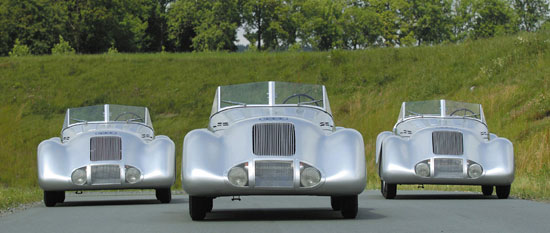
The most spectacular event for Audi Tradition in 2004 is about to take place: three Wanderer Streamline Special sports cars will participate in the Liège-Rome-Liège long-distance run from June 20 to 26, 2004. 65 years have passed since Auto Union won the team event in 1939. These three marvellous cars are authentic replicas. Audi Tradition has owned two of the streamlined roadsters since the autumn of 2003; one of these precious silver vehicles belongs to Belgian Audi importer D’Ieteren.
The three legendary sports cars will be driven through the Ardennes, the Vosges and Jura mountains, the Alps, the Aosta valley and Tuscany during the six days of the event and will travel a total distance of approx. 2,000 kilometres. The race will start in Liège/Spa (B), and prizes will be awarded to the winners of the daily stages in Vittel (F), Aix-les-Bains (F), Isola 2000 (F), Viareggio (I), Grosseto (I) and Rome (I). The 2,802-metre Col de la Bonette mountain pass is definitely one of the climaxes of the race. This will be a maiden run with spectators and genuine competition!
“This international constant-speed rally is a real challenge for these sports cars; it won’t be all that easy to make it to the end of this difficult route. Our goal is to use our historic cars mainly where they formerly appeared in races,” explains Thomas Frank, Head of Audi Tradition.
Shortly after it was held for the first time in 1931, the Liège-Rome-Liège long-distance trial had acquired a reputation as “the most difficult international non-stop long-distance reliability run”. Stopping was only allowed for re-fuelling in this event, which has also been praised as the “Queen of the rallies”. The driving teams, who had to average at least 50 kilometres per hour on the roads at the time, sat at the wheel non-stop for more than 100 hours during the crossing of the Ardennes, the Alps, the Appenines and back. In 1939, all three of Auto Union’s Wanderer Streamline Special cars reached the finish: The driver combinations Momberger/Weidauer and Müller/Menz both had the same number of points and took fourth place, the Trägner/Fritzsching team was twelfth. Auto Union thus won the important team prize for factory entries – the “Coupe des Constructeurs”. In 1938, however, Auto Union had bad luck: The leading Krämer/Münzert team had to give up only 30 kilometres before reaching the finishing line due to a minor camshaft defect.
The Wanderer Streamline Special sports car is 4.35 metres long, 1.65 metres wide and 1.28 metres high. An aluminium-bodied roadster, it weighs just 900 kilogrammes and has a top speed of 160 km/h and a power output of 70 bhp (at 4,800 rpm). The six-cylinder engine has three carburettors and a capacity of two litres, and was designed by Ferdinand Porsche, who developed a new generation of engines for the Wanderer brand in the early 1930s. Building up the cars was a big challenge for restorer Werner Zinke of Zwönitz, Saxony. Says Zinke, “I had no reliable data except the wheelbase and track measurements. I got most of the information I needed from historic pictures.” After a wire grid model, a wood model was built on the basis of computer calculations. The sheet metal was beaten manually on leather sacks and smoothed with the “English roll”. The work took two years to complete.
The four rings of the Audi badge symbolise the brands Audi, DKW, Horch and Wanderer, which were later combined under the umbrella of Auto Union. Auto Union and NSU, which merged in 1969, made many significant contributions towards the development of the car. AUDI AG was formed from Audi NSU Auto Union AG in 1985. Together with the two traditional companies Auto Union GmbH and NSU GmbH, Audi Tradition nurtures and presents the deep and diverse history of Audi. The Audi museum mobile at the Audi Forum Ingolstadt is open from Monday to Sunday, from 9 a.m. to 6 p.m.
 |
 |
Photos/Text; Audi Tradition

